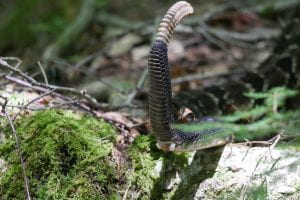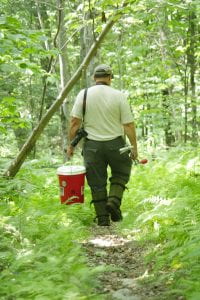Tom Tyning, the grand Steward and Guardian of the reptiles, of course, could describe this section on rattlesnake conservation much better than I since he is one of the undisputed “Gods of Herpatology”. I can tell you that timber rattlesnakes are endangered in MA, CT, VT, NH, and have been extripated from RI, ME and Canada as far as I know. I began assisting Tom, well, I’m not really sure when, but I’m pretty certain it was a point where he was in dire need of an extra set of hands, perhaps a few years back. In those earlyT days and even now, my primary goal is to not traumatize any snake to the point where from the snake’s perspective, that I look like a prime candidate for a snake bite. So While Tom weighs, measures, obtains the tissue sample; or the occasional radio transmitter onto the snake’s rattle, I talk the snake through the procedure; making relatively certain that the soundwaves projected from my voice vibrate off of the table and directly under the snake, in an attempt that he or she perceives the most reassuring vibrations that I can conjure up. All of this while keeping the “business end” of the snake safely inside of a plastic tube like the image shown below.

We, (by we, I mean Tom), injects an identifier chip (called a pit tag) into the snake, so should the snake be recaptured, the iidentification code can be used to help monitor the snake’s commings and goings, hence aiding in their conservation Monitoring the snakes is especially helpful if the animal is radio tagged. The radio transmitter helps to fill in the gaps in information of the animal’s movements in real time. Once Tom finishes the examination with the snake, the animal is returned to the wild.
Our little friend in the photographic images, (well, not so little) was a large male, strong like a bull, but had a very gentle disposition as far as venemous snakes go. I’ve decided to call him Ferdinand,(in honor of the flower smelling bull, of course).

One of the most exciting things I’ve ever learned about many of the non human life forms who share this planet with us, is that snakes; like bears, cats, and dogs use chemical secretions that can be perceived by scent. These scents are used for communication among the many animal populations in their respected territories, including snakes. Yesterday, for the very first time, I watched Ferdinand the snake “speak in his native language”. It was brilliant.






